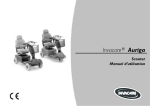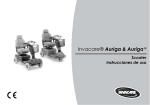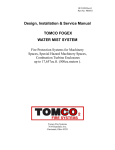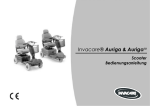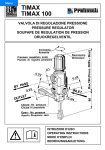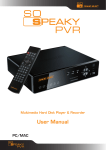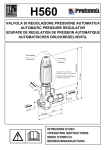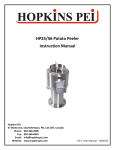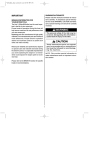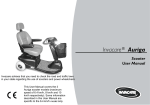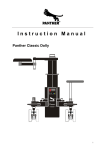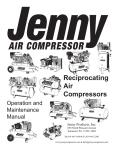Download Auriga User Manual
Transcript
Invacare Canada LP. Auriga10 3 & 4 Wheel Scooter User Manual How can you get in touch with Invacare®? If you have any questions or need support, please contact your authorised Invacare® Dealer, who has the necessary know-how and equipment plus the special knowledge concerning your Invacare® product, and can offer you all-round satisfactory service. Should you wish to contact Invacare® directly, you can reach us in Canada at the following addresses and phone numbers. Invacare Canada LP. 570 Matheson Blvd Unit #8 Mississauga, ON L4Z 4G4 Tel: 800-668-5324 Fax: 800-668-5478 2 Table of Contents Chapter 1 Introduction 1.1 1.2 1.3 2 5 6 3 23 Disengaging Motors ................................................................................................................23 The Control Panel 6.1 18 19 Before driving for the first time..............................................................................................19 Taking Obstacles.....................................................................................................................20 Driving up and down gradients..............................................................................................21 Parking and stationary............................................................................................................22 4.4.1 Activating and de-activating the parking brake (option) ...............................................22 Pushing the scooter by hand 5.1 11 General Safety Notes ..............................................................................................................11 Safety information with regard to care and maintenance ...................................................14 Safety Information on Electromagnetic Interference...........................................................15 Safety Information on Driving and Freewheel Mode............................................................16 Key features Driving 4.1 4.2 4.3 4.4 6 Important symbols in this manual ...........................................................................................8 Important symbols found on the vehicle ............................................................................... 9 Type classification and permissible use...............................................................................10 Safety Notes 2.1 2.2 2.3 2.4 3 4 Page 24 Control Panel layout................................................................................................................24 6.2 6.3 6.4 7 Adjustment Options 7.1 7.2 7.3 7.4 7.5 8 6.1.1 Seat Lifter Button ( N o t A v a i l a b l e o n C a n a d i a n M o d e l ) .................................25 6.1.2 Status display ...............................................................................................................25 6.1.3 Battery charge display ..................................................................................................26 Driving the Scooter .................................................................................................................27 Diagnostics and Trouble Shooting........................................................................................28 6.3.1 Diagnosing Faults .........................................................................................................29 Error Codes and Diagnostic Codes.......................................................................................30 Adjusting the angle of the backrest ......................................................................................33 Adjusting the position of the seat from front to back .........................................................34 Adjusting the width of the armrests ......................................................................................35 Releasing the seat so that it may rotated and/or removed .................................................36 Adjusting the height of the seat.............................................................................................37 Electrical System 8.1 8.2 39 Electronics Protection System ..............................................................................................39 8.1.1 The main fuse ...............................................................................................................40 Batteries ...................................................................................................................................40 8.2.1 What you need to know about batteries .......................................................................40 8.2.2 Charging the batteries ..................................................................................................42 8.2.3 Removing and fitting batteries ......................................................................................45 8.2.3.1 Removing the batteries............................................................................................46 8.2.3.2 How to handle damaged batteries correctly ............................................................47 9 Care and maintenance 10 Repair Instructions 10.1 33 48 50 Repairing a flat tire ................................................................................................................. 50 10.1.1 Repairing a flat tire (pneumatic tires type 260 x 85)................................................... 51 10.1.1.1 Removing a rear wheel............................................................................................51 4 10.1.1.2 10.1.1.3 10.1.1.4 Removing a front wheel (4-Wheel Version).............................................................52 Removing a front wheel (3-Wheel Version).............................................................53 Repairing the flat tire .............................................................................................. 54 11 Dismantling the scooter for transport 11.1 11.2 Removing the seat...................................................................................................................56 Removing the batteries and the Drive Unit...........................................................................57 11.2.1 Removing the batteries.................................................................................................57 11.2.2 Removing the Drive Unit...............................................................................................58 12 Disposal 13 Technical Specifications 14 Inspections Performed 5 56 59 60 61 1 Introduction Dear user, First we would like to thank you for purchasing our product! We hope you will enjoy your new Scooter. This manual contains important hints and information on: • Safety • Operation • Care and maintenance. Please take care to read the user manual thoroughly before starting out on your first journey. This product has been designed to fit the needs of different types of users with different requirements. The decision whether the model is suitable for the user may only be taken by medical specialists with appropriate aptitude. Invacare® or their representatives can accept no liability in cases in which the mobility product has not been adapted to suit the user's handicaps. Some maintenance and settings can be carried out by the user. Certain adjustments do however require technical training and may only be carried out by your Invacare® specialist dealer. Damages and errors caused by nonobservance of the operating manual or as a result of incorrect maintenance are excluded from all guarantees. 6 This manual contains copyrighted information. It may not be reproduced or copied in whole or in part without the prior written consent of Invacare® or its authorized representative. It may also contain information that pertains to models sold only in certain countries. In this case the information will be clearly marked as pertaining to a particular country-specific version. We reserve the right to make any alterations on the grounds of technical improvements. 7 1.1 Important symbols in this manual WARNING! This symbol warns you of danger! • Always follow the instructions to avoid injury to the user or damage to the product! EXPLOSION HAZARD! This symbol warns you of an explosion hazard, which can be caused by excessive tyre pressure in a pneumatic tire! • Always follow the instructions to avoid injury to the user or damage to the product! BURN HAZARD! This symbol warns you of burns due, for example, to leaking battery acid! • Always follow the instructions to avoid injury to the user or damage to the product! NOTE: This symbol identifies general information which is intended to simplify working with your product and which refers to special functions. Requirements: • This symbol identifies a list of various tools, components and items which you will need in order to carry out certain work. 8 1.2 Important symbols found on the vehicle This product may contain substances that could be harmful to the environment if disposed of in places (landfills) that are not appropriate according to legislation. • The 'crossed out wheelie bin' symbol is placed on this product to encourage you to recycle wherever possible. • Please be environmentally responsible and recycle this product through your recycling facility at its end of life. 9 1.3 Type classification and permissible use This vehicle was designed for persons whose ability to walk is impaired, but who are still physically and mentally able to operate an electric vehicle. Because of its size it is less suitable for use in indoor environments, but has a longer driving range and the ability to overcome larger and more difficult obstacles in outdoor settings. You can find exact information on speed, turning radius, range, safe climbing ability, maximum obstacle height and permissible operating conditions in chapter "Technical Specifications" on page 61. Please also pay attention to all safety information in chapter "Safety Notes" starting from page 14. 10 2 Safety Notes • 2.1 READ WELL BEFORE OPERATION! General Safety Notes Danger of injury if this scooter is used in any other way than the purpose described in this manual! • Adhere strictly to the instructions in this user manual! Danger of injury if the scooter is driven when your ability to drive is impaired by medication or alcohol! • Never drive any vehicle under the influence of medication or alcohol! Danger of damage or injury if the scooter is accidentally set into motion! • Switch the power system off before you get in, get out or handle awkward objects! • Be aware that there are only the motor brakes to stop your scooter. When the motors are disengaged, these brakes are automatically deactivated. For this reason, freewheel operation is only recommended on flat surfaces, never on gradients. Never leave your vehicle on a gradient with its motors disengaged. Always re-engage the motors immediately after pushing the vehicle. 11 Danger of injury if the On/Off Button is pressed while the vehicle is in motion, due to it coming to an abrupt, sharp stop! • If you have to brake in an emergency, simply release the drive lever, which will bring you to a halt! Only switch the vehicle off while in motion as a last resort! Danger of injury if the scooter is transported in another vehicle with the occupant seated in it! • Never transport the scooter with the occupant seated in it! Danger of injury if maximum permissible load is exceeded! • Do not exceed the maximum permissible load (see technical specifications)! Danger of injury when lifting heavy components! • When maintaining, servicing or lifting any part of your scooter, take into account the weight of the individual components, especially the batteries! Be sure at all times to adopt the correct lifting posture and ask for assistance if necessary! Danger of injury if you fall off the scooter! • If restraining systems are installed (such as seat belts), use them each time you drive the scooter. 12 Danger of injury by moving parts! • Make sure that no injury is incurred by moving parts of the scooter, like wheels or a Seat Lifter, especially when children are around! Danger of fire or breaking down due to electric devices being connected! • Do not connect any electric devices to your vehicle that are not expressly certified by Invacare® for this purpose! Have all electrical installations done by your authorised Invacare® Dealer! Danger of technical failure and injury if unauthorized spare parts and components are used! • Only use original Invacare® spare parts, which have been approved for use with this vehicle! 13 2.2 Safety information with regard to care and maintenance Danger of accident and loss of guarantee if maintenance is insufficient! • For reasons of safety and in order to avoid accidents which result from unnoticed wear, it is important that this electric vehicle undergoes an inspection once every year under normal operating conditions (see inspection plan contained in service instructions)! • Under difficult operating conditions such as daily travel on steep slopes, or in the case of use in medical care cases with frequently changing wheelchair users, it would be expedient to carry out intermediate checks on the brakes, accessories and running gear! • If the vehicle is to be operated on public roads, the vehicle driver is responsible for ensuring that the vehicle is in an operationally reliable condition! Inadequate or neglected care and maintenance of the vehicle will result in a limitation of the manufacturer's liability! 14 2.3 Safety Information on Electromagnetic Interference This electric vehicle was successfully tested in accordance with International standards as to its compliance with Electromagnetic Interference (EMI) Regulations. However, electromagnetic fields, such as those generated by radio and television transmitters, and cellular phones, can influence the functions of electric vehicles. Also, the electronics used in our vehicles can generate a low level of electromagnetic interference, which however will remain within the tolerance permitted by law. For these reasons we ask you to please observe the following precautions: WARNING: Danger of malfunction due to electromagnetic interference! • Do not switch on or operate portable transceivers or communication devices (such as radio transceivers or cellular phones) when the vehicle is switched on! • Avoid getting near strong radio and television transmitters! • In case the vehicle should be set in motion unintentionally or the brakes are released, switch it off immediately! • Adding electrical accessories and other components or modifying the vehicle in any way can make it susceptible to electromagnetic interference. Keep in mind that there is no sure way to determine the effect such modifications will have on the overall immunity of the electronic system! • Report all occurrences of unintentional movement of the vehicle, or release of the electric brakes to the manufacturer! 15 2.4 Safety Information on Driving and Freewheel Mode Danger of injury if the vehicle tips over! • Only ever negotiate gradients up to the maximum tilt-resistant gradient and only with the backrest in an upright position, and the seat lifter in the lowest position (if installed)! • Only ever drive downhill at a maximum of 2/3rds of the top speed! Avoid abrupt braking or accelerating on gradients! • If at all possible, avoid driving on slippery surfaces (such as snow, gravel, ice etc.) where there is a danger of you losing control over the vehicle, especially on a gradient! If driving on such a surface is inevitable, then always drive slowly and with the utmost caution! • Never attempt to overcome an obstacle when on an uphill or downhill gradient! • Never attempt to drive up or down a flight of steps! • Always approach obstacles straight on! Ensure that the front wheels and rear wheels move over the obstacle in one stroke, do not stop halfway! Do not exceed the maximum obstacle height (see Technical Specifications pg.60)! • Avoid shifting your centre of gravity as well as abrupt changes of direction when the vehicle is in motion! 16 Danger of injury if the vehicle tips over! (Continued) • Never use the vehicle to transport more than one person! • Do not exceed the maximum permissible load! • When loading the vehicle, always distribute the weight evenly! Always try to keep the centre of gravity of the vehicle in the middle, and as close to the ground as possible! • Note that the vehicle will brake or accelerate if you change the Driving Speed while it is in motion! Danger of injury if you collide with an obstacle when driving through narrow passages such as doorways and entrances! • Drive through narrow passages in the lowest Driving Speed and with due caution! 17 3 Key features 1) De-clutching lever 2) Release lever for swivelling and removing seat (under the seat on the right) 3) Release lever for seat sliding rail adjustment (under the seat on the right in the front) 4) Primary Charging Socket 5) Key switch (ON/OFF) 6) Throttle 7) Control panel 8) Lever for adjusting the angle of the steering column 9) Handbrake / parking brake (if installed) Auriga 3 Wheel Scooter 18 4 Driving 4.1 Before driving for the first time... Before you take your first trip, you should familiarize yourself well with the operation of the vehicle and with all operating elements. Take your time to test all functions and driving modes. NOTE: If installed, use the restraining systems (seat belts) each time you use the vehicle. Sitting Comfortably = Driving Safely Before each trip, make sure that: 19 • You are within easy reach of all operating controls. • The battery charge is sufficient for the distance intended to be covered. • The restraining belt (if installed) is in perfect order. 4.2 Taking Obstacles Your Invacare® Auriga 3 & 4 Wheel scooter can overcome obstacles and curbs of up to 8 cm. CAUTION: Danger of Tipping Over! • Never approach obstacles at an angle! • Put your backrest into an upright position before climbing an obstacle! Driving up over an obstacle • Correct Approach the curb or obstacle slowly head-on. Shortly before the front wheels touch the obstacle, increase the speed and reduce only after the rear wheels have also climbed the obstacle. Driving down off of an obstacle • Approach the curb or obstacle slowly head-on. Before the front wheels touch the obstacle, reduce speed and keep it until also the rear wheels have come down off of the obstacle. Incorrect 20 4.3 Driving up and down gradients The maximum tilt-resistant climbing ability for the Invacare® Auriga/Auriga10 depends on the version and the load capacity: • 4-Wheel Version (up to 150 kg or 330lbs payload): 12° • 3-Wheel Version (up to 120 kg or 265lbs payload): 12° • 3-Wheel Version (up to 150 kg or 330lbs payload): 10° WARNING: Danger of tipping over! • Only ever drive downhill at a maximum of 2/3rds of the top speed! • Always return the backrest of your seat to an upright position before ascending slopes! We recommend that you lean the backrest slightly to the rear before descending slopes! • Never attempt to ascend or descend a slope on slippery surfaces or where there is a danger of skidding (such as wet pavement, ice etc)! • Avoid trying to get out of the vehicle on an incline or a gradient! • Always drive in a straight direction along the road or path you are travelling on, rather than attempting to zigzag! • Never attempt to turn around on an incline or a slope! 21 4.4 Parking and stationary When parking your vehicle or if your vehicle is stationary for a prolonged period: 4.4.1 • Switch the vehicle's power system off (key switch). • Activate the parking brake (if available). Activating and de-activating the parking brake (option) Activating the brake • Pull brake lever (1) and hold it. • While holding the brake lever, press the latching pin (2) down. The brake lever is latched in place. Releasing the brake • Pull the brake lever briefly and let it go. The latching pin pops up. The brake lever is released. 22 5 Pushing the scooter by hand The motors of the scooter are equipped with automatic brakes, preventing the scooter from rolling away out of control when the power supply is switched off. When pushing the scooter, the magnetic brakes must be disengaged. 5.1 Disengaging Motors Danger of the vehicle running away! • When the motors are disengaged (for push operation), the electromagnetic motor brakes are deactivated! When the vehicle is parked, the levers for engaging and disengaging the motors must without fail be locked firmly into the "DRIVE" position (electromagnetic motor brakes activated)! The lever for engaging and disengaging the motor is located on the right at the rear of the scooter. Disengaging the motor • Make sure the power supply is switched off (key switch). • Push lever (1) forwards. Engaging the motor • 23 Pull lever backwards. 6 The Control Panel 6.1 Control Panel layout 1) Seat Lifter button (if installed) 2) Battery charge indicator 3) Hazard flashers 4) Horn 5) Right turn signal 6) Driving speed adjustment 7) Throttle lever 8) Plug for external charger 9) Reduced Speed Mode 10) Left turn signal 11) Lights 24 6.1.1 Seat Lifter Button - Not Available on Canadian Model • Press the button to activate the Seat Lifter (if installed). The LED above the button lights up. • Raise or lower the seat using the throttle lever. • Press the button once again to de-activate the Seat Lifter. The throttle lever reverts back to driving mode. NOTE If the Seat Lifter is not lowered entirely, then the speed of the scooter is automatically reduced to lower the risk of tipping over. This is indicated by the LED just above the "Reduced Speed Mode" button flashing. Lower the Lifter completely to restore speed to it's normal level. The LED will go out. 6.1.2 Status display NOTE The leftmost diode of the battery charge display serves as an error message display (status display). For an explanation of the Error Codes please see chapter "Error Codes and Diagnostic Codes" on page "30". 25 Battery charge display • • • All diodes lit: full driving range Only red and yellow diodes lit: decreased drive range. Charge batteries at end of journey. Only red diodes lit / flashing: battery reserve = very low drive range! Charge batteries immediately! NOTE Total discharge protection: After a certain drive time on reserve battery power the electronics switches off the drive automatically and the scooter will be immobile. 26 6.2 Driving the Scooter • Switch on the power supply (key switch). The displays on the Control Panel light up. The scooter is ready to drive. NOTE If the scooter does not respond after switching on, check the status display (see chapter "Status display" on page 26 and chapter "Diagnostics and Trouble Shooting" on page 29). • Set the driving speed with the speed adjustment knob. • Gently pull the right driving lever towards you to drive forwards. • Gently pull the left driving lever towards you to drive backwards. NOTE The controller is programmed with standard values ex-works. Your Invacare® Dealer can program it to fit your requirements. NOTE: To brake quickly, simply let go of the driving lever. It will automatically return to the middle position. The scooter will brake. 27 6.3 Diagnostics and Trouble Shooting The electronics system provides diagnostics information to assist technicians to diagnose and correct faults within the scooter system. The existence of a fault will cause the status light to flash in bursts, separated by a pause. The nature of the fault is indicated by the number of flashes in each burst, also referred to as the Flash Code. Depending on the severity of the fault and impact on user safety, the electronic system will react differently. It may… • Simply display the Flash Code as a warning and allow normal driving and operation. • Display the Flash Code, stop the scooter and prevent driving until the electronic system has been turned off and then back on again. • Display the Flash Code, stop the scooter and prevent driving until the fault has been fixed. For detailed descriptions of what each Flash Code means, and the probable cause and remedy, see Section "Error Codes and Diagnostic Codes" on page 30. 28 6.3.1 Diagnosing Faults Use the following troubleshooting guide if the scooter fails to operate. NOTE Turn the key switch on before beginning any diagnostics. If the Status Light is OFF Check that the key switch is turned ON. Check that all cables are connected correctly. If only the leftmost diode of the battery charge display is PERMANENTLY ON Contact your authorised Invacare® Dealer If the leftmost diode of the battery charge display is FLASHING Count the number of flashes and refer to the next section. 29 6.4 Error Codes and Diagnostic Codes Number of flashes 1 2 Fault Impact on Scooter Will drive Battery needs charging Battery voltage Drive inhibited too low Notes • • • Lifter raised 3 Driving speed reduced Battery voltage Drive inhibited too high • • • Battery charge is running low. Recharge the batteries as soon as possible. Battery charge is empty. Recharge the batteries. If the scooter is left off for a few minutes, battery charge may recover sufficiently to allow driving for a short period of time. You should only ever do this in an emergency, as this deep-discharges the batteries! Lower lifter completely. Battery charge is too high. If a charger is plugged in, unplug it. The electronic system charges the batteries when travelling down slopes or decelerating. Excessive charging in this manner may cause this fault. Turn the scooter power off and then back on again. Turn on the lighting system to use power. 30 Number of flashes 4 Fault Current Limit Time Out Impact on Scooter Drive inhibited Notes • • 5 Brake Fault Drive inhibited • • 6 Out Of Neutral Drive inhibited At Power Up • • 31 7 Speed Pot Error Drive inhibited • 8 Motor Volts Error Drive inhibited • The scooter has drawn too much current for too long, possibly because the motor has been over-worked, jammed or stalled. Turn the scooter power off, leave it off for a few minutes, and then turn the power back on again. The controller has detected a shortcircuited motor. Check the cable harness for short and check the motor: Contact your authorized Invacare Canada Dealer. Check that the declutching lever is in the engaged position. The park brake coil or wiring is faulty. Check the park brake and wiring for open or short circuits. Contact your authorized Invacare Canada Dealer. Throttle is not in neutral position when turning key switch on. Return throttle to neutral, turn power off, and back on again. Throttle may need to be re-calibrated. Contact your authorized Invacare Canada Dealer. The throttle or its wiring may be faulty or incorrectly set up. Contact your authorized Invacare Canada Dealer. The motor or its wiring is faulty. Contact your authorized Invacare Canada Dealer. Number of flashes 9 Fault Other Internal Errors Impact on Scooter Drive inhibited Notes • Contact your authorized Invacare® Canada Dealer. 32 7 Adjustment Options 7.1 Adjusting the angle of the backrest The backrest is held in place by a metal plate on each side. Each plate has 4 holes that are used to set the backrest to different angles. This is done by selecting different combinations of holes. Requirements: • Allen key, 4 mm • Wrench, 10 mm 33 • Remove the screws on both sides of the seat that hold the backrest (1), using the spanner and Allen key. • Adjust the backrest to the desired angle. • Reposition the screws and tighten. 7.2 Adjusting the position of the seat from front to back The lever for adjusting the seat back and forth is located under the seat in the front on the right side. • Pull the lever (1) to release the seat. • Slide the seat forward or backward to the desired position. • Release the lever to lock the seat in place. 34 7.3 Adjusting the width of the armrests The knobs to release the armrests are located in the back, under the seat (1). 35 • Turn the knobs to release the armrests. • Adjust the armrests to the desired width. • Retighten the knobs. 7.4 Releasing the seat so that it may rotate and/or be removed The seat can be rotated to the side to ease getting on and off of the scooter. In this position, the seat can also be removed. The lever for releasing the seat so that it can be rotated is located under the seat on the right (1). • Push the lever forward to release the seat. • Rotate the seat to the side. • If desired, firmly grip the seat by the backrest and the front edge and pull upwards to remove it. 36 7.5 Adjusting the height of the seat The height of the seat can be adjusted to 16", 17", 18", or 19". Requirements: • 2 Wrenches, 17 mm 37 • Remove the seat • Remove the cover from the battery and motor compartment. • Remove the bolt that hold the seat post, using the two wrenches. NOTE Do not use the uppermost hole. In this position the seat is too low, and does not have enough clearance above the cowling. • Adjust the seat height. • Reposition the bolt and tighten. 38 8 Electrical System 8.1 Electronics Protection System The vehicle's electronics are equipped with an overload-protection system. If the motors are put under considerable strain for a longer period of time (for example, when driving up a steep hill) and especially when the ambient temperature is high, then the electronic system could overheat. In this case the vehicle's power is reduced gradually until it finally comes to a halt. The Status Display shows a corresponding error code. By switching the power supply off and back on again, the error code is cancelled and the electronics are switched back on. It will take approximately five minutes until the electronics have cooled down enough for the motors to restore full power again. When the motors are stalled by an insurmountable obstacle, such as a high kerb, and the vehicle driver allows the motors to strain against this hindrance for more than 20 seconds without moving, then the electronics will automatically switch off to prevent the motors from being damaged. The Status Display shows a corresponding error code. By switching off and back on again, the error code is cancelled and the electronics are switched back on. 39 8.1.1 The main fuse The entire electric system is protected against overload by two master fuses. The master fuses are mounted on the positive battery cables. NOTE A defective main fuse may be replaced only after checking the entire electric system. An Invacare Canada specialized or authorized dealer must perform the replacement. 8.2 Batteries 8.2.1 What you need to know about batteries Power is supplied by two 12V gel batteries. The batteries are maintenance-free and only need regular charging. New batteries should always be fully charged once before their first use. New batteries will be at their full capacity after having run through approx. 10 - 20 charging cycles. How fast the batteries will be discharged will depend on many circumstances, such as ambient temperature, condition of the surface of the road, tire pressure, weight of the driver, way of driving and utilization of lighting, etc. 40 Note Regarding Batteries, Please Read! Gel batteries are not hazardous goods. Gel batteries may be transported without restrictions, whether by road, rail or by air. Individual transport companies have, however, guidelines which can possibly restrict or forbid certain transport procedures. Please ask the transport company regarding each individual case. Pay attention to the Battery Charge Indicator! Make sure to charge the batteries when the Battery Charge Indicator shows that battery charge is low. We recommend charging the batteries after each trip, as well as each night over night. Depending on the level of discharge, it can take up to 12 hours until the batteries are fully charged again. Protect your charger from sources of heat such as heaters and direct sunlight. If the battery charger overheats, charging current will be reduced and the charging process delayed. To avoid damaging the batteries, never allow them to be fully discharged. Do not drive on heavily discharged batteries if it is not absolutely necessary, as this will strain the batteries unduly and shorten their life expectancy. In case your vehicle is not used for a longer period of time, then the batteries must be charged at least once a month to maintain a full charge. Alternatively, the vehicle can stay connected to the charger. The batteries cannot be overcharged with the specified charger. Please use only charging devices in Class 2. This class of chargers may be left unattended during charging. All charging devices which are supplied by Invacare® and comply with these requirements. 41 8.2.2 Charging the batteries • Make sure you read and understand the battery charger's User's Manual, as well as the safety notes on the front and rear panels of the charger! WARNING: Danger of explosion and destruction of batteries if the wrong battery charger is used! • Only ever use the battery charger supplied with your vehicle, or a charger that has been approved by Invacare®! Danger of electric shock and damage to the battery charger if it is allowed to get wet! • Protect the battery charger from water! • Always charge in a dry environment! Danger of short circuit and electric shock if the battery charger has been damaged! • Do not use the battery charger if it has been dropped or damaged! Danger of fire and electric shock if a damaged extension cable is used! • Only ever use an extension cable if it is absolutely necessary! In case you must use one, make sure it is in good condition! Note The Invacare® Auriga 3 Wheel /4 Wheel can be charged using an internal or an external charger. Although it is not inherently dangerous to use both simultaneously, we recommend using only one at a time. On board charger not available on Canadian models. 42 How can I tell when the batteries are fully charged? LED ACTIVITY LED lights contantly Start LED dims and flickers 90% Finished LED go out / flickers for a few seconds / Finished goes out again CHARGING PHASE 43 The Invacare® Auriga 3 Wheel /4 Wheel are charged by using an external charger. The charging socket is on rear edge of the Control Panel (1). Connecting the charger • Switch off the Scooter. • Connect the battery charger to the Scooter. • Connect the battery charger to the main. Disconnecting the charger • First disconnect the battery charger from the main power supply. • Then disconnect the battery charger from the scooter. 44 8.2.3 Removing and fitting batteries WARNING: Danger of injury if the batteries are not handled correctly during assembly and maintenance work! • New batteries should be installed by authorised technicians! • Observe the warnings on the batteries! • Take into account the heavy weight of the batteries! • Only ever use the battery type defined in the technical specifications! Danger of fire and burns if battery terminals are short-circuited! • DO NOT short-circuit battery terminals with a tool! WARNING: Corrosion and burns from acid leakage if batteries are damaged! • Remove clothes that have been soiled by acid immediately! After contact with skin: • Immediately wash affected area with lots of water! After contact with eyes: • Immediately rinse eyes under running water for several minutes; consult a physician! 45 8.2.3.1 Removing the batteries Requirements: • Wrench 11 mm • Remove the seat. • Remove the battery and motor compartment cover. • Disconnect the main cable harness. • Open the belts that hold the batteries in place (1). • Loosen battery clamp of the blue cable at the negative pole of the battery with the wrench and remove cable. • Loosen the battery clamp of the red cable at the positive pole of the battery with the wrench and remove cable. • Repeat procedure on the other side. NOTE Fitting of new batteries is done in reverse order. 46 8.2.3.2 How to handle damaged batteries correctly WARNING: Corrosion and burns from acid leakage if batteries are damaged! • Remove clothes that have been soiled by acid immediately! After contact with skin: • Immediately wash affected area with lots of water! After contact with eyes: • Immediately rinse eyes under running water for several minutes; consult a physician! Requirements: • Safety goggles • Acid-resistant gloves • Acid-resistant receptacle for transportation • Always wear appropriate safety clothing when handling damaged batteries. • Place damaged batteries in an acid-resistant receptacle immediately after removing them. • Only ever transport damaged batteries in an appropriate acid-resistant receptacle. • Wash all objects that have come into contact with acid with lots of water. Disposing of dead or damaged batteries correctly Dead or damaged batteries can be given back to your dealer or directly to Invacare®. 47 9 Care and maintenance NOTE: Have your vehicle checked once a year by an authorised Invacare Canada dealer in order to maintain it's driving safety and roadworthiness. Cleaning the vehicle When cleaning the vehicle, pay attention to the following points: • Only use a damp cloth and gentle detergent. • Do not use any abrasive or scouring liquids. • Do not subject the electronic components to any direct contact with water. • Do not use high-pressure cleaning devices. Disinfection Spray or wipe disinfection using a tested and recognised product is permitted. . 48 Seat and backrest padding: • Check for perfect condition. Tyres: • Have tires checked for specified air pressure (2,5 bar). Front wheels • Front wheels must spin smoothly. • If wheels wobble or do not spin easily, adjust steering pivot pin or front wheel bearing. Rear wheels: • Test wheel for firm seat on the axle drive shaft. • Rear wheels must spin without wobbling Electronics / Electrical System: • Check all plug connections for condition and firm connection. • Have batteries been fully charged before the daily operation? • Are all holders, screws firmly fixed, tight and safe? • Are all electric bulbs of the lighting system (if applicable) in working order? Cleaning: • Clean all parts carefully. Monthly Weekly When Delivered Maintenance Jobs Before every trip Before each trip When necessary Once a year you should have your vehicle inspected and serviced by your authorised dealer. A complete checklist of necessary maintenance work can be found in the Service Manual, which can be obtained from Invacare Canada. 49 10 Repair Instructions The following are instructions on repairs that can be performed by the user. For the specifications of spare parts please see "Technical Specifications" on page 60, or consult the Service Manual, available from Invacare® (in this connection please see the addresses and phone numbers in section "How can you get in touch with Invacare®?" on page 2). In case you require assistance, please contact your Invacare Canada Dealer. 10.1 Repairing a flat tire WARNING: Danger of damage or injury if the vehicle is accidentally set into motion during repairs! • Switch the power off (ON/OFF Button)! • Engage the motors! • Secure the vehicle against rolling away by placing wedges under the wheels! 50 10.1.1 Repairing a flat tire (pneumatic tires type 260 x 85) 10.1.1.1 Removing a rear wheel Requirements: • Wrench 19 mm • Rubber hammer • Jack the vehicle up and place a block of wood underneath it to prop it up. • Remove the nut that secures the wheel (1) using the 19 mm spanner. • Remove the wheel, using the rubber hammer to coax it off of the axle by gently hitting it on the rear side. Having trouble removing the wheel? You might need to use a special tool. Please ask your authorized Invacare Canada Dealer for assistance. Re-assembly Re-assembly is done in reverse order. Make sure that the wheel is put back on the same side it was on, and that it runs in the same direction it did before it was removed. 51 10.1.1.2 Removing a front wheel (4-Wheel Version) Requirements: • Allen key 6 mm • Rubber hammer • Jack the vehicle up and place a block of wood underneath it to prop it up. • Remove the nut that secures the wheel (1) using the 6 mm Allen key. • Remove the wheel, using the rubber hammer to coax it off of the axle by gently hitting it on the rear side. Re-assembly Re-assembly is done in reverse order. Make sure that the wheel is put back on the same side it was on, and that it runs in the same direction it did before it was removed. 52 10.1.1.3 Removing a front wheel (3-Wheel Version) Requirements: • 2 wrenches, 17 mm • Tilt the scooter over on it's side. • Remove the bolts that hold the wheel (1) using the two spanners, then remove the wheel from the fork. Re-assembly Re-assembly is done in reverse order. Make sure that the wheel runs in the same direction it did before it was removed. 53 10.1.1.4 Repairing the flat tire Requirements (General) • Repair kit for inner tubes or an new inner tube. • Talcum powder • Socket wrench, 13 mm Requirements (3-Wheel Version - front wheel): • Allen key, 6 mm • Remove the valve cap. • Let the air out of the tyre by pressing the pin in the centre of the valve in. • Remove the 4 nuts (1) from the rear of the wheel using the 13 mm spanner (3-Wheel Version - front wheel: counter the bolts from the other side using the 6 mm Allen key). • Remove the rim halves from the tire and take out the inner tube. • Repair the inner tube and re-fit, or replace it with a new one. 54 Did the old inner tube get wet during repair? In case the old inner tube is to be repaired and used again, and it gets wet during repair, then it is easier to re-fit it if you powder it lightly with talcum powder. 55 • Place the rim halves in the tire from the outside. • Pump up the tire a little. • Re-position the screws and nuts that hold the rim together and tighten them firmly. • Check to make sure that the tire is squarely in place on the rim. • Pump up the tyre to the recommended tire pressure (2.5 bar, or 40 psi). • Check to make sure that the tire is still squarely and snugly in place on the rim. • Screw the valve cap back on. • Refit the wheel. 11 Dismantling the scooter for transport To dismantle the scooter for transport, proceed as follows: • Remove the seat • Remove the batteries • Remove the drive unit The scooter is re-assembled in reverse order. 11.1 Removing the seat The lever for releasing the seat so that it can be rotated and removed is located under the seat on the right (1). • Push the lever forward to release the seat. • Rotate the seat to the side. • Firmly grip the seat by the backrest and the front edge and pull upwards to remove it. 56 11.2 Removing the batteries and the Drive Unit • After removing the seat, proceed to remove the cover from the battery and motor compartment Cover. It is held in place with Velcro strips, so you only need to pull it upwards to remove it. 11.2.1 Removing the batteries For instructions on how to remove the batteries see chapter "Removing and fitting batteries" on page 45. 57 11.2.2 Removing the Drive Unit WARNING: Danger of injury by moving parts! • The release lever for the drive unit is under tension! When releasing the drive unit be very careful not to get your hands or feet caught underneath the chassis of the scooter, or in between any moving parts! To release the drive unit, first you need to remove the securing pin that prevents the release lever from opening accidentally. • Remove the pin (1) that secures the latching mechanism. • Release the drive Unit by pressing the Release Lever (2) forward and downward. 58 12 59 Disposal • The equipment wrapping is potentially recyclable. • The metal parts are used for scrap metal recycling. • The plastic parts are used for plastic recycling. • Electric components and printed circuit boards are disposed of as electronic scrap. • Disposal must be carried out in accordance with the respective national legal provisions. • Ask your city or district council for details of the local waste management companies. 13 Technical Specifications TECHNICAL SPECIFICATIONS Electrical System / Motor Batteries Main battery fuse (10 km/h) Weight ( Incl Batteries) Maximum load Height Width Length (w/o bumpers and anti-tippers) Seat height (measured from the chassis, manuallyadjustable) Backrest height (w/o headrest) Backrest height (with headrest) Backrest angle (manually adjustable) Seat width Seat depth Armrest height Tire pressure Speed Safe climbing capability 120 kg load: Safe climbing capability up to 150 kg load: Maximum obstacle height Minimum turning radius Range 10 km/h version with 40 Ah batteries Color Charging System Auriga 3 Auriga 4 295 W (10 km/h) 295 W (10 km/h) 2 x 40 AH 2 x 40 AH 80A 80A 194lbs 208lbs 332lbs 332lbs 47" 47" 24" 24" 47" 48" 18-20" 18-20" 17" 17" 25" 25" 0°, 10°, 15°, 30° 0°, 10°, 15°, 30° 17-21 1/2 " 17-21 1/2 " 17 1/2" 17 1/2" 9-11" 9-11" 40 psi 40 psi 10 km/h (6,2 mph) 10 km/h (6,2 mph) 12° 12° 10° 10° 3"(8 cm) 3"(8 cm) 47" 59" 32 km (20 miles) 32 km (20 miles) Red & Blue Red & Blue Off Board Off Board 60 14 Inspections Performed It is confirmed by stamp and signature that all jobs listed in the inspection schedule of the Service and Repair Instructions have been properly performed. The list of the inspection jobs to be performed can be found in the Service Manual which is available through Invacare®. Delivery Inspection 1st Annual Inspection Stamp of authorized Dealer / Date / Signature Stamp of authorized Dealer / Date / Signature Stamp of authorized Dealer / Date / Signature Stamp of authorized Dealer / Date / Signature Stamp of authorized Dealer / Date / Signature Stamp of authorized Dealer / Date / Signature 2nd Annual Inspection 4th Annual Inspection 62 3rd Annual Inspection 5th Annual Inspection 63 English Form No. of this Manual: 1418468.DOC Release Date: 03.29.06






























































